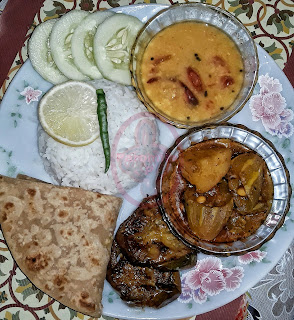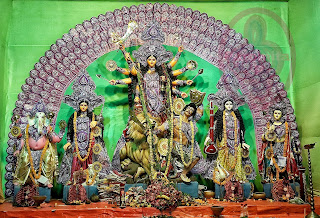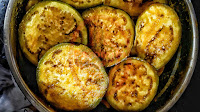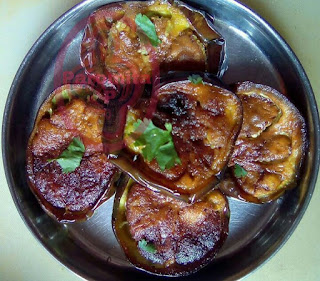Bengali Veg Recipes
My country India is a land with different traditions,
culture, customs, food habits and different mythological stories. During the
festivals people organize different varieties of food recipes and also we have
many different ways of celebrating these festivals at the same time. However,
we all are bound together when it comes to the sharing of love and happiness in
festivals. This is the
biggest festival time of the year with ‘Dussehra’ and then ‘Diwali’. Dussehra has different names, stories, and way of celebration all over the country. I’m a
Bengali, hence I know a little more about my state's Puja story.
Unlike the other states, here in West Bengal and other eastern and North-eastern states of India, this festival is celebrated as ‘Durga Puja’, where Maa Durga kills Mahishasur on the day of ‘Mahalaya’, gaining a victory of good over the evil, and saving the world from falling into the rule of evil powers, she then brings peace and happiness, that is why Maa Durga is known as ‘Durgotinashini’. Ever since she brought victory from that day onwards we start celebrating the festival of victory. In Bengal the story says, Maa Durga along with her four children – Lakshmi, Saraswati, Karthik and Ganesh visits her Father’s house for these nine days. Since her husband, ‘Shiv’ is a Yogi (meditator), the place where he resides ‘Kailash’ is a pure vegetarian divine place and that’s why when Maa Parvati (Shiva’s wife, another name of Maa Durga) visits her father’s house, they prepare varieties of non-vegetarian dishes.
Unlike the other states, here in West Bengal and other eastern and North-eastern states of India, this festival is celebrated as ‘Durga Puja’, where Maa Durga kills Mahishasur on the day of ‘Mahalaya’, gaining a victory of good over the evil, and saving the world from falling into the rule of evil powers, she then brings peace and happiness, that is why Maa Durga is known as ‘Durgotinashini’. Ever since she brought victory from that day onwards we start celebrating the festival of victory. In Bengal the story says, Maa Durga along with her four children – Lakshmi, Saraswati, Karthik and Ganesh visits her Father’s house for these nine days. Since her husband, ‘Shiv’ is a Yogi (meditator), the place where he resides ‘Kailash’ is a pure vegetarian divine place and that’s why when Maa Parvati (Shiva’s wife, another name of Maa Durga) visits her father’s house, they prepare varieties of non-vegetarian dishes.
However, there are other different stories and different
eating habits too in other parts of the country, people in west celebrate
‘Navaratri’ doing fasting for nine days and eat only veg, people in the south celebrate ‘Dasara’
where even they prepare vegetarian dishes, people in the north have mixed
culture and I’m not pretty sure about their eating habits though. However
northern India has a different story for ‘Dussehra’ celebration, where Lord Ram
fought with Lanka King ‘Ravana’ to save his wife and defeated Ravana on the
tenth day which is known as ‘Vijaya Dashami’ and that’s why people burn the
idol of Ravana on this day. Although we have different ways to celebrate this
festival but at the end, it marks the
victory of good over evil in any way.
Mythological stories are means to spread lessons and
ethnicity in the heart of people in different ways. However, the main purpose
of these festivals is to keep alive the
culture, traditions, respect for elders, purity in heart and faith in God. Also, it brings the family and friends together
with more love so that it erases any ill feelings, jealousy, hatred or
misunderstanding from their heart. And of course
what more give the pleasure of celebrating these festivals are ‘Food’, we
Indians prepare different varieties of dishes to offer God and also our guests.
Bengalis usually prepare fish in any occasion, however on the eighth day ie,
’Durga Ashtami’, we offer ‘Pushpanjali’ in the very morning, and the whole day
we prepare only vegetarian dishes. This day marks officially the main Durga
Puja in Kolkata, as banks and offices get holidays from this day onwards for 3 to 4 days ie, until Dashami.
 Here are few dishes that we prepared for our guests,
the whole family gathers together in arranging, cooking, serving and eating. We do
not use onion, garlic or any other flesh item on this day. A complete Vegetarian delight for the festive season. These dishes were mainly prepared for the ‘Durga Ashtami’, however, it can be
prepared for any other occasions as well when you need vegetarian options.
These are typical Bengali dishes, and I’ve not used my fusion recipe concepts
for them, so when you need to look for any homemade simple Bengali veg recipes,
you got the options here. Very easy methods to prepare and gives the flavor of
Bengali household recipes. The
plate includes steamed rice and plain paratha in the main course; parwal curry, dal fry and eggplant fry as side
dishes with salads.
Here are few dishes that we prepared for our guests,
the whole family gathers together in arranging, cooking, serving and eating. We do
not use onion, garlic or any other flesh item on this day. A complete Vegetarian delight for the festive season. These dishes were mainly prepared for the ‘Durga Ashtami’, however, it can be
prepared for any other occasions as well when you need vegetarian options.
These are typical Bengali dishes, and I’ve not used my fusion recipe concepts
for them, so when you need to look for any homemade simple Bengali veg recipes,
you got the options here. Very easy methods to prepare and gives the flavor of
Bengali household recipes. The
plate includes steamed rice and plain paratha in the main course; parwal curry, dal fry and eggplant fry as side
dishes with salads.
Following are the Recipes with step by step instructions:
Potoler Dalna (Parwal Curry)
[Veg]
Prep Time: 5 minutes
Cooking Time: 45 mins
Course: Side
Cuisine: Indian/Bengali
Serves: 4
Measuring Items: 1cup=150ml, Teaspoon
Ingredients:
- Potol (pointed gourd/parwal) – 300 grams
- Potato- 5
- Ginger- an inch sized
- Green chili- 4
- Tomato- 2
Spices:
- Turmeric powder- 1 Tsp
- Mirchi powder- 2 Tsp
- Salt (as per taste)
- Mustard Oil- 1 ½ cup
- Panch Phoron (5 spices mixture)- 1 tsp (traditional Bengali dishes often start the seasoning with these five spices together- cumin, fennel, nigella, fenugreek and brown mustard seeds. Bengali kitchen usually keep a jar of these 5 seeds mixed together ready for the seasoning)
Method:
- Cut the parval into half and marinate with little salt and turmeric powder for 10 minutes.
- Heat oil in a cooking wok or kadhai, fry the parwal pieces lightly till they are golden brown and keep aside.
- Now in the same kadhai, add a bit of oil. Once the oil is hot enough, put the panchphoron, ginger (minced), chili (sliced half), tomato slices. Sauté for 2 minutes.
- Add turmeric and Mirchi powder, then put the potato cubes. Cover and cook until potatoes are soft.
- Once potatoes are done, add the fried parwal and mix well.
- Add 2 cups water and bring to a boil. Once the gravy becomes a bit thick, the curry is ready.
Chana
Dal Fry (lentils fry)
[Veg]
Ingredients:
- Chana Dal (Split Bengal Gram)- 250 grams
- Ginger- an inch
- Green chili- 4
- Dry red chili- 2
- Tomato- 4
- Panch Phoron- 1 tsp
- Turmeric powder- 2 tsp
- Mirchi powder- 2 tsp
- Bay leaf - 2
- Salt- as per taste
- Mustard oil- 1 cup
Method:
- Wash chana dal properly. In a pressure cooker put 1 ½ cup of the lentil to 2 ½ cups of water with a pinch of salt and turmeric powder. Pressure cook for 3 whistles.
- Heat oil in a wok put the panch phoron, bay leaf, dry Mirchi, minced ginger, green chili and sliced tomatoes, sauté for 2 minutes.
- Add the turmeric and Mirchi powder, fry for 2 minutes. Now add the cooked dal and 1 cup of water.
- Allow it to boil until the gravy gets thickened.
Begun
Bhaja (Aubergine fry)
- Wash the brinjal, cut them into thick slices and marinate with salt and ½ tsp turmeric powder for at least 20 minutes.
- Heat 1 cup oil in a frying pan or wok, put the brinjal slices slowly into the hot oil and fry both the sides.
The Bengali grand vegetarian Thali is ready to be served. The overall cooking time that I took was 1 ½ hour from arranging, chopping, cooking, cleaning and decorating the plate. It feels great to cook and serve to the guests especially during the festival time, which is actually called the sharing of joy and happiness. Alongside we also serve some sweets, which is a must for any occasion in a Bengali lunch/dinner.
"May Maa Durga bless everyone with love and
sweetness in their life."
||Happy Dussehra|| ||Subho Bijoya Doshomi||
Paromita Pramanick ©2017. All Rights Reserved.









Help us make more transplants possible!
ReplyDeleteWe are urgently in need of kidney donors in (NKC) to help patients who face life time dialysis problem unless they under go Kidney Transplant. Here we offer financial rewards to interested donors. For more details contact us via Email: kidneylivertc@gmail.com